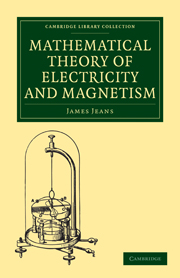Book contents
- Frontmatter
- Preface
- Contents
- Introduction
- ELECTROSTATICS AND CURRENT ELECTRICITY
- MAGNETISM
- ELECTROMAGNETISM
- CHAP. XIII The Magnetic Field Produced by Electric Currents
- CHAP. XIV Induction of Currents in Linear Circuits
- CHAP. XV Induction of Oueeents in Continuous Media
- CHAP. XVI Dynamical Theory of Currents
- CHAP. XVII Displacement Currents and Electromagnetic Waves
- CHAP. XVIII The Electromagnetic Theory of Light
- CHAP. XIX The Motion of Electrons
- CHAP. XX The Theory of Relativity
- CHAP. XXI The Electrical Structure of Matter
- INDEX
CHAP. XIV - Induction of Currents in Linear Circuits
from ELECTROMAGNETISM
Published online by Cambridge University Press: 05 August 2011
- Frontmatter
- Preface
- Contents
- Introduction
- ELECTROSTATICS AND CURRENT ELECTRICITY
- MAGNETISM
- ELECTROMAGNETISM
- CHAP. XIII The Magnetic Field Produced by Electric Currents
- CHAP. XIV Induction of Currents in Linear Circuits
- CHAP. XV Induction of Oueeents in Continuous Media
- CHAP. XVI Dynamical Theory of Currents
- CHAP. XVII Displacement Currents and Electromagnetic Waves
- CHAP. XVIII The Electromagnetic Theory of Light
- CHAP. XIX The Motion of Electrons
- CHAP. XX The Theory of Relativity
- CHAP. XXI The Electrical Structure of Matter
- INDEX
Summary
PHYSICAL PRINCIPLES.
It has been seen that, on moving a magnetic pole about in the presence of electric currents, there is a certain amount of work done on the pole by the forces of the field. If the conservation of energy is to be true of a field of this kind, the work done on the magnetic pole must be represented by the disappearance of an equal amount of energy in some other part of the field. If all the currents in the field remain steady, there is only one store of energy from which this amount of work can be drawn, namely the energy of the batteries which maintain the currents, so that these batteries must, during the motion of the magnetic poles, give up more than sufficient energy to maintain the currents, the excess amount of energy representing work performed on the poles. Or again, if the batteries supply energy at a uniform rate, part of this energy must be used in performing work on the moving poles, so that the currents maintained in the circuits will be less than they would be if the moving poles were at rest.
Let us suppose that we have an imaginary arrangement by which additional electromotive forces can be inserted into, or removed from, each circuit as required, and let us suppose that this arrangement is manipulated so as to keep each current constant.
- Type
- Chapter
- Information
- Mathematical Theory of Electricity and Magnetism , pp. 452 - 472Publisher: Cambridge University PressPrint publication year: 2009First published in: 1908

